头痛图 1-3
- 格式:doc
- 大小:74.00 KB
- 文档页数:3
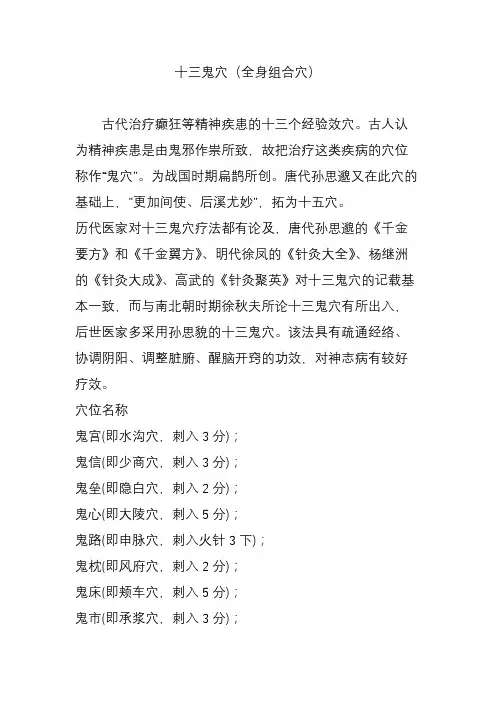
十三鬼穴(全身组合穴)古代治疗癫狂等精神疾患的十三个经验效穴。
古人认为精神疾患是由鬼邪作祟所致,故把治疗这类疾病的穴位称作“鬼穴”。
为战国时期扁鹊所创。
唐代孙思邈又在此穴的基础上,"更加间使、后溪尤妙",拓为十五穴。
历代医家对十三鬼穴疗法都有论及,唐代孙思邈的《千金要方》和《千金翼方》、明代徐凤的《针灸大全》、杨继洲的《针灸大成》、高武的《针灸聚英》对十三鬼穴的记载基本一致,而与南北朝时期徐秋夫所论十三鬼穴有所出入,后世医家多采用孙思貌的十三鬼穴。
该法具有疏通经络、协调阴阳、调整脏腑、醒脑开窍的功效,对神志病有较好疗效。
穴位名称鬼宫(即水沟穴,刺入3分);鬼信(即少商穴,刺入3分);鬼垒(即隐白穴,刺入2分);鬼心(即大陵穴,刺入5分);鬼路(即申脉穴,刺入火针3下);鬼枕(即风府穴,刺入2分);鬼床(即颊车穴,刺入5分);鬼市(即承浆穴,刺入3分);鬼窟(即劳宫穴,刺入2分);鬼堂(即上星穴,刺入2分);鬼藏(即会阴穴,刺入3分);鬼腿(亦称鬼臣,即曲池穴,火针刺入5分);鬼封(即海泉穴,在舌下中缝,刺出血,乃横安板1枚,就两口吻,令舌不能动);再加间使、后溪穴尤妙。
操作方法常规消毒后,持不锈钢毫针依次针刺十三鬼穴,男子先针左,女子先针右。
单日为阳,双日为阴,阳日阳时针右转,阴日阴时针左转。
施强刺激针法,不留针。
适用范围十三鬼穴疗法适用于一切精神疾患,如癔病、精神分裂症、癫狂等,也可用于由高热所致的狂躁不安等证。
歌诀孙真人"十三鬼穴"歌百邪为疾状癫狂,十三鬼穴须推祥。
一针鬼宫人中穴,二针鬼信取少商,鬼垒三针为隐白,鬼心四刺大陵岗,申脉五针通鬼路,风府六针鬼枕旁,七针鬼床颊车穴,八针鬼市闹承浆,九刺劳宫钻鬼窟,十刺上星登鬼堂,十一鬼藏会阴取,玉门头上刺娇娘,十二曲池淹鬼腿,十三鬼封舌下藏,出血须令舌不动,更加间使后溪良,男先针左女先右,能令鬼魔立刻降。
穴位定位1.水沟穴(鬼宫)DU26 Shuǐ gōu别名:人中[定位]在面部,当人中沟的上1/3与中1/3交点处。
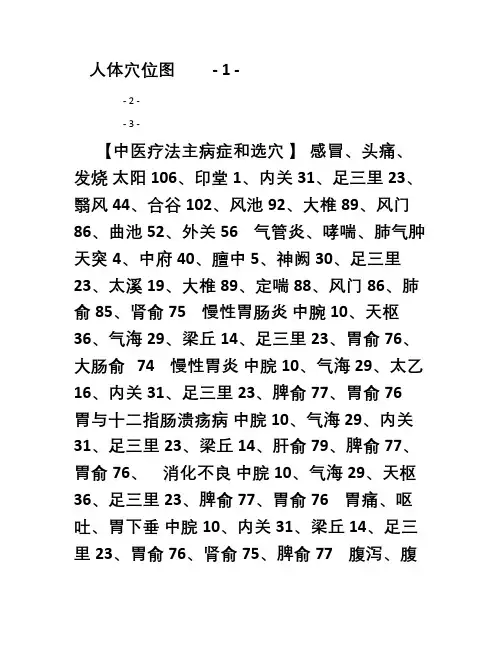
人体穴位图 - 1 -- 2 -- 3 -【中医疗法主病症和选穴】感冒、头痛、发烧太阳106、印堂1、内关31、足三里23、翳风44、合谷102、风池92、大椎89、风门86、曲池52、外关56 气管炎、哮喘、肺气肿天突4、中府40、膻中5、神阙30、足三里23、太溪19、大椎89、定喘88、风门86、肺俞85、肾俞75 慢性胃肠炎中腕10、天枢36、气海29、梁丘14、足三里23、胃俞76、大肠俞 74 慢性胃炎中脘10、气海29、太乙16、内关31、足三里23、脾俞77、胃俞76 胃与十二指肠溃疡病中脘10、气海29、内关31、足三里23、梁丘14、肝俞79、脾俞77、胃俞76、消化不良中脘10、气海29、天枢36、足三里23、脾俞77、胃俞76 胃痛、呕吐、胃下垂中脘10、内关31、梁丘14、足三里23、胃俞76、肾俞75、脾俞77 腹泻、腹痛中脘10、天枢36、关元28、内关31、梁丘14、足三里23、胃俞76、肾俞75、大肠俞74 慢性结肠炎〔五更泻〕中脘10、神阙30、天枢36、气海29、内关31、足三里23、脾俞77、胃俞76、命门57、大肠俞74 慢性肝炎膻中5、中脘10、阳陵泉97、大椎89、身柱47、肺俞85、肝俞79、胆俞78、脾俞77、胃俞76 高血压肩井45、血压点90、足三里23、三阴交21、风池92、大椎89、身柱47、肝俞79、胆俞78、曲池52、涌泉108 低血压天突4、膻中5、神阙30、足三里23、太溪19、大椎89、定喘88、风门86、肺俞85、身柱47、肝俞79、胆俞78、百会94、太阳106、风池92、膈俞81、印堂1、三阴交21、涌泉108 冠心病〔心绞痛〕膻中5、内关31、足三里23、三阴交21、大椎89、心俞83、肝俞79、阙阴俞82 风湿性心脏病膻中5、郄门33、关元28、内关31、足三里23、厥阴俞82、心俞83、肾俞75、关元俞73 肺心病膻中5、曲泽35、气海29、关元28、内关31、足三里23、三阴交21、大椎89、定喘88、风门86、肺俞85、厥阴俞82、心俞83、肾俞75 糖尿病中脘10、气海29、关元28、中极12、足三里23、三阴交21、太溪19、肺俞85、胰俞51、肾俞75、命门57、痛泉108 神经衰弱〔失眼、多梦〕内关31、足三里23、三阴交21、心俞83、肾俞75、谷合102、涌泉108、失眠107 中风后遗症曲泽35、内关31、百会94、大椎89、肩髃39、曲池52、外关56、合谷102、膀胱经落枕风池92、肩井45、大椎89、外关56、合谷102 颈椎病印堂1、曲泽35、内关31、风池92、肩井45、肩髃39、大椎89、肺俞85、外关56、曲池52、合谷102 肩周炎缺盆3、足三里23、风池92、大椎89、天宗84、曲池52、外关56、合谷 - 4 -102、大杼91 急性腰扭伤、慢性腰痛、腰肌劳损承山64、昆仑63、肾俞75、腰眼59、腰阳关60、关元俞73、委中66 腰椎间盘突出〔增生〕症承山64、昆仑63、委中66、殷门67、承扶67、关元俞73、腰眼59、肾俞75 坐骨神经痛肾俞75、腰眼59、关元俞73、承扶69、殷门67、委中66、承山64、昆仑63、涌泉108 类风湿性关节炎曲泽35、内关31、膝关节、督脉、膀胱经、肘关节、外关56、合谷102、承山64 膝关节痛梁丘14、膝眼24、阴陵泉18、足三里23、委中66、阳陵泉97、承山 64 强直性脊椎炎肩井45、大椎89、膀胱、委中66 静脉曲张足三里23、三阴交21、涌泉108、承山64 股骨头坏死阿是穴、肾俞75、承扶69、殷门67、委中66、承山64 痛经、月经不调天枢36、气海29、关元28、中极12、足三里23、次髎31、三阴交21、大椎89、肾俞75、关元俞73 更年期综合症中脘10、气海29、内关31、关元28、足三里23、三阴交21、太溪19、大椎89、膀胱经、合谷102 目赤肿痛眩晕大椎89、身柱47、肝俞79、胆俞78、百会94、太阳106、风池92、印堂1、三阴交21、能泉108 慢性鼻炎印堂1、迎香43、百会94、风池92、大椎89、风门86、肺俞85、曲池52、合谷102 扁桃体炎人迎2、天突4、曲泽35、孔最32、太溪19、大椎89、曲池52、肾俞75、合谷102 慢性咽炎人迎2、天突4、曲泽35、缺盆3、大椎89、风门86、曲池52、合谷 102 湿疹血海15、神阙30、足三里23、三阴交21、大椎89、肝俞85、曲池52 荨麻疹血海15、足三里23、三阴21、大椎89、风门86、肝俞79、曲池52 慢性肾炎中脘10、水分38、气海29、关元28、中极12、足三里23、三阴交21、太溪19、肝俞79、脾俞77、肾俞75、命门57 拔罐常用穴位的取穴方法〔1〕局部穴位的取穴方法:百会:头正中线与两耳尖联线的交点处风府:头顶正中线,后发际上1寸处风池:在枕骨粗隆直下,风府两旁凹陷处,在斜方肌和胸锁乳突肌之间取穴 - 5 -印堂:两眉头联线的中点处凹陷处太阳:在眼外眦后约1寸凹陷处迎香:在鼻翼旁0.5寸,鼻凹陷沟中下关:闭口,颧弓与下颌切迹所形成的凹陷处。
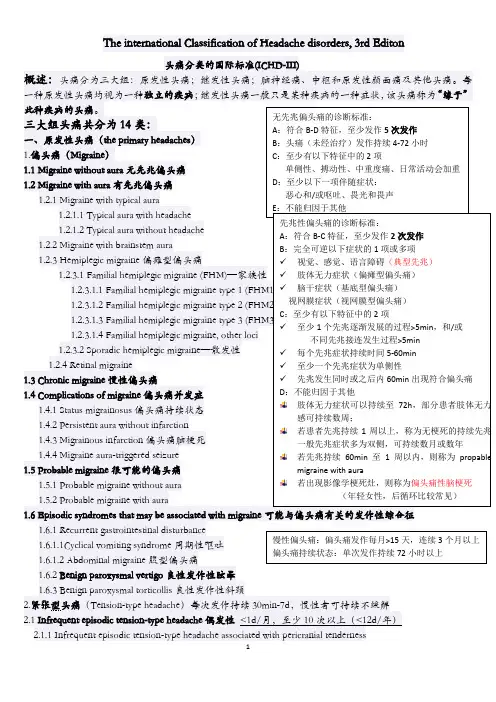
The international Classification of Headache disorders, 3rd Editon头痛分类的国际标准(ICHD-III)概述:头痛分为三大组:原发性头痛;继发性头痛;脑神经痛、中枢和原发性颜面痛及其他头痛。
每一种原发性头痛均视为一种独立的疾病;继发性头痛一般只是某种疾病的一种症状,该头痛称为“缘于”此种疾病的头痛。
三大组头痛共分为14类: 一、原发性头痛(the primary headaches ) 1.偏头痛(Migraine ) 1.1 Migraine without aura 无先兆偏头痛 1.2 Migraine with aura 有先兆偏头痛 1.2.1 Migraine with typical aura 1.2.1.1 Typical aura with headache 1.2.1.2 Typical aura without headache 1.2.2 Migraine with brainstem aura 1.2.3 Hemiplegic migraine 偏瘫型偏头痛1.2.3.1 Familial hemiplegic migraine (FHM)—家族性 1.2.3.1.1 Familial hemiplegic migraine type 1 (FHM1) 1.2.3.1.2 Familial hemiplegic migraine type 2 (FHM2) 1.2.3.1.3 Familial hemiplegic migraine type 3 (FHM3) 1.2.3.1.4 Familial hemiplegic migraine, other loci 1.2.3.2 Sporadic hemiplegic migraine —散发性 1.2.4 Retinal migraine 1.3 Chronic migraine 慢性偏头痛1.4 Complications of migraine 偏头痛并发症1.4.1 Status migrainosus 偏头痛持续状态 1.4.2 Persistent aura without infarction 1.4.3 Migrainous infarction 偏头痛脑梗死 1.4.4 Migraine aura-triggered seizure 1.5 Probable migraine 很可能的偏头痛 1.5.1 Probable migraine without aura1.5.2 Probable migraine with aura 1.6 Episodic syndromes that may be associated with migraine 可能与偏头痛有关的发作性综合征1.6.1 Recurrent gastrointestinal disturbance1.6.1.1Cyclical vomiting syndrome 周期性呕吐 1.6.1.2 Abdominal migraine 腹型偏头痛1.6.2 Benign paroxysmal vertigo 良性发作性眩晕1.6.3 Benign paroxysmal torticollis 良性发作性斜颈2.紧张型头痛(Tension-type headache )每次发作持续30min-7d ,慢性者可持续不缓解2.1 Infrequent episodic tension-type headache 偶发性 <1d/月,至少10次以上(<12d/年)2.1.1 Infrequent episodic tension-type headache associated with pericranial tenderness无先兆偏头痛的诊断标准:A :符合B-D 特征,至少发作5次发作B :头痛(未经治疗)发作持续4-72小时C :至少有以下特征中的2项单侧性、搏动性、中重度痛、日常活动会加重D :至少以下一项伴随症状:恶心和/或呕吐、畏光和畏声E :不能归因于其他 先兆性偏头痛的诊断标准:A :符合B-C 特征,至少发作2次发作B :完全可逆以下症状的1项或多项✓ 视觉、感觉、语言障碍(典型先兆)✓ 肢体无力症状(偏瘫型偏头痛)✓ 脑干症状(基底型偏头痛)视网膜症状(视网膜型偏头痛)C :至少有以下特征中的2项 ✓ 至少1个先兆逐渐发展的过程>5min ,和/或 不同先兆接连发生过程>5min ✓ 每个先兆症状持续时间5-60min✓ 至少一个先兆症状为单侧性✓ 先兆发生同时或之后内60min 出现符合偏头痛 D :不能归因于其他 肢体无力症状可以持续至72h ,部分患者肢体无力感可持续数周; 若患者先兆持续1周以上,称为无梗死的持续先兆一般先兆症状多为双侧,可持续数月或数年 若先兆持续60min 至1周以内,则称为propablemigraine with aura若出现影像学梗死灶,则称为偏头痛性脑梗死 (年轻女性,后循环比较常见) 慢性偏头痛:偏头痛发作每月>15天,连续3个月以上 偏头痛持续状态:单次发作持续72小时以上4.5 Cold-stimulus headache 冷刺激性头痛 4.5.1 Headache attributed to external application of a cold stimulus4.5.2 Headache attributed to ingestion or inhalation of a cold stimulus 4.5.3 Probable cold-stimulus headache4.5.3.1 Headache probably attributed to external application of a cold stimulus4.5.3.2 Headache probably attributed to ingestion or inhalation of a cold stimulus 4.6 External-pressure headache 4.6.1 External-compression headache 4.6.2 External-traction headache 4.6.3 Probable external-pressure headache4.6.3.1 Probable external-compression headache 4.6.3.2 Probable external-traction headache 4.7 Primary stabbing headache4.7.1 Probable primary stabbing headache4.8 Nummular headache4.8.1 Probable nummular headache4.9 Hypnic headache4.9.1 Probable hypnic headache4.10 New daily persistent headache (NDPH) 新症每日持续性头痛4.10.1 Probable new daily persistent headach 二、继发性头痛(the secondary headaches )5.缘于头、颈部外伤的头痛(Headache attributed to trauma or injury to the head and/or neck )5.1 Acute headache attributed to traumatic injury to the head5.1.1 Acute headache attributed to moderate or severe traumatic injury to the head5.1.2 Acute headache attributed to mild traumatic injury to the head5.2 Persistent headache attributed to traumatic injury to the head5.2.1 Persistent headache attributed to moderate or severe traumatic injury to the head5.2.2 Persistent headache attributed to mild traumatic injury to the head5.3 Acute headache attributed to whiplash5.4 Persistent headache attributed to whiplash5.5 Acute headache attributed to craniotomy5.6 Persistent headache attributed to craniotomy6.缘于头颈部血管疾病的头痛(Headache attributed to cranial or cervical vascular disorder )6.1 Headache attributed to ischaemic stroke or transient ischaemic attack6.1.1 Headache attributed to ischaemic stroke (cerebral infarction)6.1.2 Headache attributed to transient ischaemic attack (TIA)6.2 Headache attributed to non-traumatic intracranial haemorrhage6.2.1 Headache attributed to non-traumatic intracerebral haemorrhage 非外伤性脑出血6.2.2 Headache attributed to non-traumatic subarachnoid haemorrhage (SAH)6.2.3 Headache attributed to non-traumatic acute subdural haemorrhage (ASDH)急性硬膜下血肿NDPH 诊断标准: A :持续性头痛,符合B-C 的标准B :Distinct and clearly remembered onset, with pain becomingcontinuous and unremitting within 24 hours C :Present for>3 monthsD :除外其他疾患 慢性头痛,起病急,可清晰回忆发病时间为哪一天 疼痛缺乏特点,可以为偏头痛,可以为紧张性,亦可两者混合 若患者符合慢性偏头痛或慢性紧张型头痛的标准,则不诊断NDPH 若患者为药物过度使用性头痛,且符合NDPH 的标准, 则可两者均可作为诊断6.3 Headache attributed to unruptured vascular malformation 未破裂的血管畸形6.3.1 Headache attributed to unruptured saccular aneurysm囊性动脉瘤6.3.2 Headache attributed to arteriovenous malformation (AVM) 动静脉畸形6.3.3 Headache attributed to dural arteriovenous fistula (DAVF) 硬膜动静脉瘘6.3.4 Headache attributed to cavernous angioma 海绵窦血管瘤6.3.5 Headache attributed to encephalotrigeminal or leptomeningeal angiomatosis (Sturge Weber syndrome) 脑三叉神经或软脑膜血管瘤病6.4 Headache attributed to arteritis6.4.1 Headache attributed to giant cell arteritis (GCA) 颞动脉炎6.4.2 Headache attributed to primary angiitis of the central nervous system (PACNS)6.4.3 Headache attributed to secondary angiitis of the central nervous system (SACNS)颞动脉炎诊断标准:美国风湿学会1990年1. 50岁以上发病:50岁以上发现症状2.新发的头痛:出现新发的局限性头痛3.颞动脉异常:颞动脉压痛或者与颈动脉的动脉硬化无关的搏动减弱4.血沉值升高:50mm/h以上5.动脉活检异常:单核细胞为主的细胞浸润或者伴多核巨细胞的肉芽肿出现为特征的血管炎证据5项中如满足3项以上,敏感度93.5%。
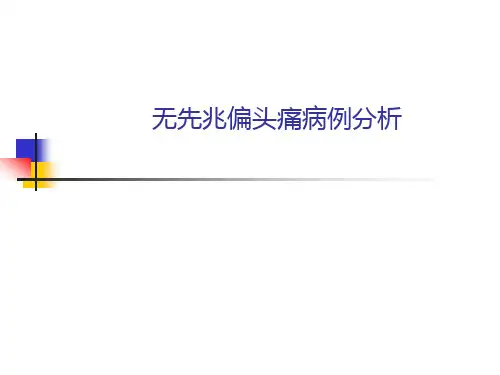
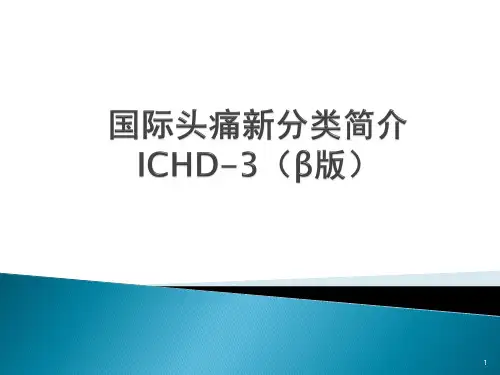

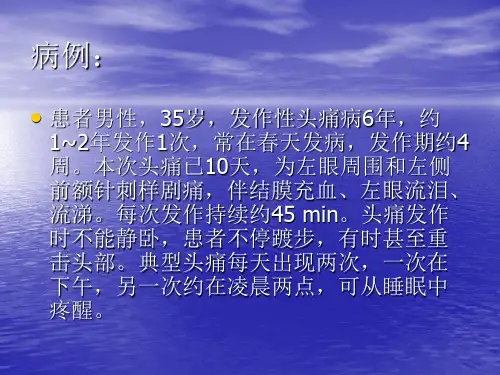
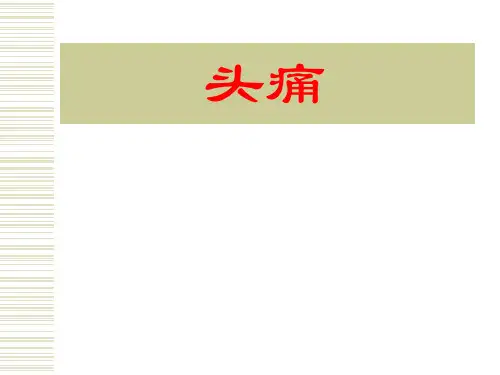
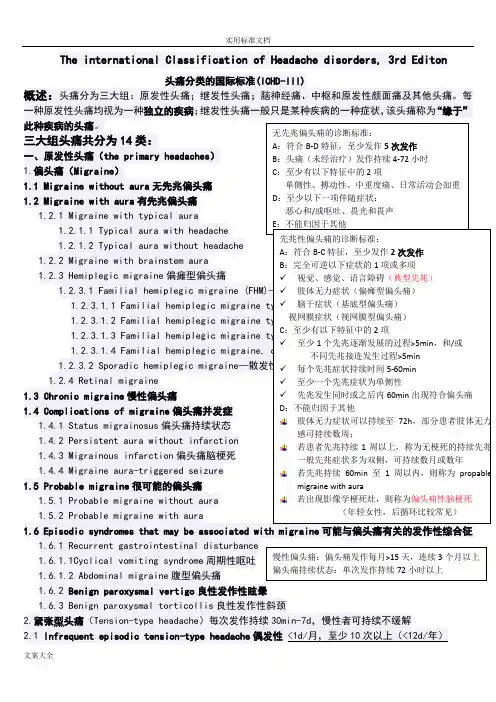
The international Classification of Headache disorders, 3rd Editon4.6.3.2 Probable external-traction headache 4.7.1 Probable primary stabbing headache6.2 Headache attributed to non-traumatic intracranial haemorrhage6.2.1 Headache attributed to non-traumatic intracerebral haemorrhage非外伤性脑出血6.2.2 Headache attributed to non-traumatic subarachnoid haemorrhage (SAH)6.2.3 Headache attributed to non-traumatic acute subdural haemorrhage (ASDH)急性硬膜下血肿6.3 Headache attributed to unruptured vascular malformation未破裂的血管畸形6.3.1 Headache attributed to unruptured saccular aneurysm囊性动脉瘤6.3.2 Headache attributed to arteriovenous malformation (AVM) 动静脉畸形6.3.3 Headache attributed to dural arteriovenous fistula (DAVF) 硬膜动静脉瘘6.3.4 Headache attributed to cavernous angioma 海绵窦血管瘤6.3.5 Headache attributed to encephalotrigeminal or leptomeningeal angiomatosis (Sturge Weber syndrome)脑三叉神经或软脑膜血管瘤病6.4 Headache attributed to arteritis6.4.1 Headache attributed to giant cell arteritis (GCA) 颞动脉炎6.4.2 Headache attributed to primary angiitis of the central nervous system (PACNS)6.4.3 Headache attributed to secondary angiitis of the central nervous system (SACNS)6.8.2 Mitochondrial Encephalopathy, Lactic Acidosis and Stroke-like episodes (MELAS)6.8.3 Headache attributed to another genetic vasculopathy6.9 Headache attributed to pituitary apoplexy垂体卒中7.缘于非血管性颅内疾病的头痛(Headache attributed to non-vascular intracranial disorder )7.1 Headache attributed to increased cerebrospinal fluid pressure颅内压增高7.1.1 Headache attributed to idiopathic intracranial hypertension (IIH)7.1.2 Headache attributed to intracranial hypertension secondary to metabolic, toxic or hormonal causes7.1.3 Headache attributed to intracranial hypertension secondary to hydrocephalus7.2 Headache attributed to low cerebrospinal fluid pressure颅内压低下7.2.1 Post-dural puncture headache腰穿后7.2.2 CSF fistula headache脑脊液漏7.2.3 Headache attributed to spontaneous intracranial hypotension自发性低颅压7.3 Headache attributed to non-infectious inflammatory disease非感染性炎性疾病7.3.1 Headache attributed to neurosarcoidosis7.3.2 Headache attributed to aseptic (non-infectious) meningitis7.3.3 Headache attributed to other non-infectious inflammatory disease7.3.4 Headache attributed to lymphocytic hypophysitis7.3.5 Syndrome of transient Headache and Neurological Deficits with cerebrospinal fluid Lymphocytosis (HaNDL)7.4 Headache attributed to intracranial neoplasia颅内新生物7.4.1 Headache attributed to intracranial neoplasm7.4.1.1 Headache attributed to colloid cyst of the third ventricle7.4.2 Headache attributed to carcinomatous meningitis癌性脑膜炎7.4.3 Headache attributed to hypothalamic or pituitary hyper- or hyposecretion7.5 Headache attributed to intrathecal injection鞘内注射7.6 Headache attributed to epileptic seizure7.6.1 Hemicrania epileptica癫痫半颅痛7.6.2 Post-ictal headache癫痫发作后头痛7.7 Headache attributed to Chiari malformation type I (CM1)7.8 Headache attributed to other non-vascular intracranial disorder8.缘于物质或物质戒断的头痛(Headache attributed to a substance or its withdrawal)8.1 Headache attributed to use of or exposure to a substance or its withdrawal缘于某种物质的应用或戒断8.1.1 Nitric oxide (NO) donor-induced headache一氧化氮诱发8.1.1.1 Immediate NO donor-induced headache8.1.1.2 Delayed NO donor-induced headache8.1.2 Phosphodiesterase (PDE) inhibitor-induced headache磷酸二酯酶抑制剂8.1.3 Carbon monoxide (CO)-induced headache一氧化碳诱发8.1.4 Alcohol-induced headache酒精诱发8.3.4 Headache attributed to withdrawal from chronic use of other substance9.缘于感染的头痛(Headache attributed to infection)9.1 Headache attributed to intracranial infection颅内感染9.1.1 Headache attributed to bacterial meningitis or meningoencephalitis细菌性脑膜炎/脑膜脑炎9.1.1.1 Acute headache attributed to bacterial meningitis or meningoencephalitis9.1.1.2 Chronic headache attributed to bacterial meningitis or meningoencephalitis9.1.1.3 Persistent headache attributed to past bacterial meningitis or meningoencephalitis9.1.2 Headache attributed to viral meningitis or encephalitis病毒性脑膜炎或脑炎9.1.2.1 Headache attributed to viral meningitis9.1.2.2 Headache attributed to viral encephalitis9.1.3 Headache attributed to intracranial fungal or other parasitic infection真菌或寄生虫感染9.1.3.1 Acute headache attributed to intracranial fungal or other parasitic infection9.1.3.2 Chronic headache attributed to intracranial fungal or other parasitic infection9.1.4 Headache attributed to brain abscess脑脓肿9.1.5 Headache attributed to subdural empyema硬膜下积脓9.2 Headache attributed to systemic infection系统感染9.2.1 Headache attributed to systemic bacterial infection系统细菌感染9.2.1.1 Acute headache attributed to systemic bacterial infection9.2.1.2 Chronic headache attributed to systemic bacterial infection9.2.2 Headache attributed to systemic viral infection系统病毒感染9.2.2.1 Acute headache attributed to systemic viral infection9.2.2.2 Chronic headache attributed to systemic viral infection9.2.3 Headache attributed to other systemic infection其他系统感染9.2.3.1 Acute headache attributed to other systemic infection9.2.3.2 Chronic headache attributed to other systemic infection10.缘于内环境紊乱的头痛(Headache attributed to disorder of homoeostasis)10.1 Headache attributed to hypoxia and/or hypercapnia缺氧和/或高碳酸血症10.1.1 High-altitude headache高海拔头痛10.1.2 Headache attributed to aeroplane travel飞行头痛10.1.3 Diving headache潜水头痛10.1.4 Sleep apnoea headache睡眠呼吸暂停性头痛10.2 Dialysis headache10.3 Headache attributed to arterial hypertension高血压性头痛10.3.1 Headache attributed to phaeochromocytoma嗜络细胞瘤10.3.2 Headache attributed to hypertensive crisis without hypertensive encephalopathy无高血压脑病的高血压危象10.3.3 Headache attributed to hypertensive encephalopathy高血压脑病10.3.4 Headache attributed to pre-eclampsia or eclampsia先兆子痫10.3.5 Headache attributed to autonomic dysreflexia自主反射障碍10.4 Headache attributed to hypothyroidism甲状腺低下10.5 Headache attributed to fasting禁食10.6 Cardiac cephalalgia心源性头痛10.7 Headache attributed to other disorder of homoeostasis其他内环境稳定失调疾患11.缘于头、颈、眼、耳、鼻、鼻窦、牙、口或其他头面部结构病变的头面痛(Headache or facial pain attributed to disorder of the cranium, neck,eyes, ears, nose, sinuses, teeth, mouth or other facial or cervical structure )11.1 Headache attributed to disorder of cranial bone颅骨11.2 Headache attributed to disorder of the neck 颈部11.2.1 Cervicogenic headache11.2.2 Headache attributed to retropharyngeal tendonitis11.2.3 Headache attributed to craniocervical dystonia11.3 Headache attributed to disorder of the eyes眼睛11.3.1 Headache attributed to acute glaucoma急性青光眼11.3.2 Headache attributed to refractive error屈光不正11.3.3 Headache attributed to heterophoria or heterotropia (latent or persistent squint)斜视11.3.4 Headache attributed to ocular inflammatory disorder11.3.5 Headache attributed to trochleitis11.4 Headache attributed to disorder of the ears耳朵11.5 Headache attributed to disorder of the nose or paranasal sinuses鼻子或鼻窦11.5.1 Headache attributed to acute rhinosinusitis急性鼻窦炎11.5.2 Headache attributed to chronic or recurring rhinosinusitis11.6 Headache attributed to disorder of the teeth or jaw11.7 Headache attributed to temporomandibular disorder (TMD)11.8 Head or facial pain attributed to inflammation of the stylohyoid ligament11.9 Headache or facial pain attributed to other disorder of cranium, neck, eyes, ears, nose,sinuses, teeth, mouth or other facial or cervical structure12.缘于精神疾病的头痛(Headache attributed to psychiatric disorder)12.1 Headache attributed to somatization disorder躯体化障碍12.2 Headache attributed to psychotic disorder精神疾病三、脑神经痛、中枢和原发性颜面痛及其他头痛(painful cranial neuropathies, other facial pains and other headaches)13.脑神经痛和中枢性颜面痛(Painful cranial neuropathies and other facial pains)13.1 Trigeminal neuralgia三叉神经痛13.1.1 Classical trigeminal neuralgia13.1.1.1 Classical trigeminal neuralgia, purely paroxysmal13.1.1.2 Classical trigeminal neuralgia with concomitant persistent facial pain。
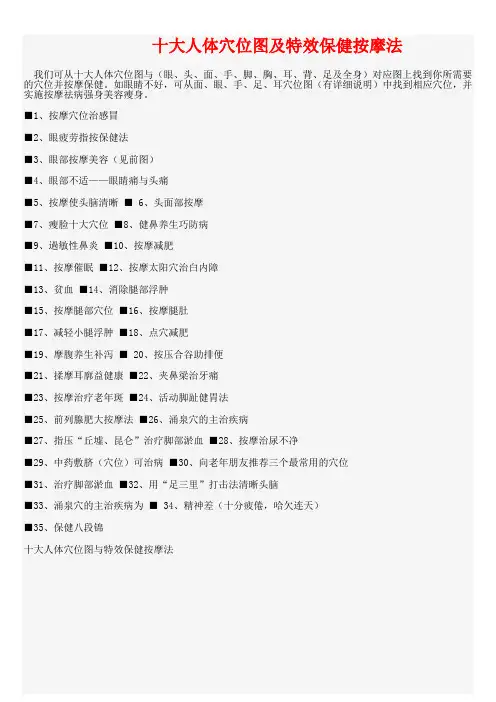
十大人体穴位图及特效保健按摩法我们可从十大人体穴位图与(眼、头、面、手、脚、胸、耳、背、足及全身)对应图上找到你所需要的穴位并按摩保健。
如眼睛不好,可从面、眼、手、足、耳穴位图(有详细说明)中找到相应穴位,并实施按摩祛病强身美容瘦身。
■1、按摩穴位治感冒■2、眼疲劳指按保健法■3、眼部按摩美容(见前图)■4、眼部不适——眼睛痛与头痛■5、按摩使头脑清晰■ 6、头面部按摩■7、瘦脸十大穴位■8、健鼻养生巧防病■9、過敏性鼻炎■10、按摩减肥■11、按摩催眠■12、按摩太阳穴治白内障■13、贫血■14、消除腿部浮肿■15、按摩腿部穴位■16、按摩腿肚■17、减轻小腿浮肿■18、点穴减肥■19、摩腹养生补泻■ 20、按压合谷助排便■21、揉摩耳廓益健康■22、夹鼻梁治牙痛■23、按摩治疗老年斑■24、活动脚趾健胃法■25、前列腺肥大按摩法■26、涌泉穴的主治疾病■27、指压“丘墟、昆仑”治疗脚部淤血■28、按摩治尿不净■29、中药敷脐(穴位)可治病■30、向老年朋友推荐三个最常用的穴位■31、治疗脚部淤血■32、用“足三里”打击法清晰头脑■33、涌泉穴的主治疾病为■ 34、精神差(十分疲倦,哈欠连天)■35、保健八段锦十大人体穴位图与特效保健按摩法1、按摩穴位治感冒选穴太阳、迎香、头维、风池;大椎;合谷、鱼际、尺泽、曲池等穴:1)啄法用剑指啄击大椎穴(见人体背部穴位图);2)揉按法(一般经2—3次治疗后即可痊愈。
如有继发细菌感染者,可配合抗生素治疗):(1)用两手拇指指腹同时揉按同侧风池、头维穴(见下图)。
(2)用两手拇指指腹分别揉按对侧尺泽、曲池、鱼际、合谷穴(见人体穴位全图中图)。
先左侧后右侧。
(3)用两手示指指腹同时揉按同侧太阳、迎香穴(见下图)。
3)注:注意保暖,勿使再受寒邪、不要过度疲劳;多饮开水,少吃油腻食物。
2、眼疲劳指按保健法1)轻闭双目,用中指按住上眼皮向上轻提,做5次;2)用中指将下眼窝(承)向下轻按5次。
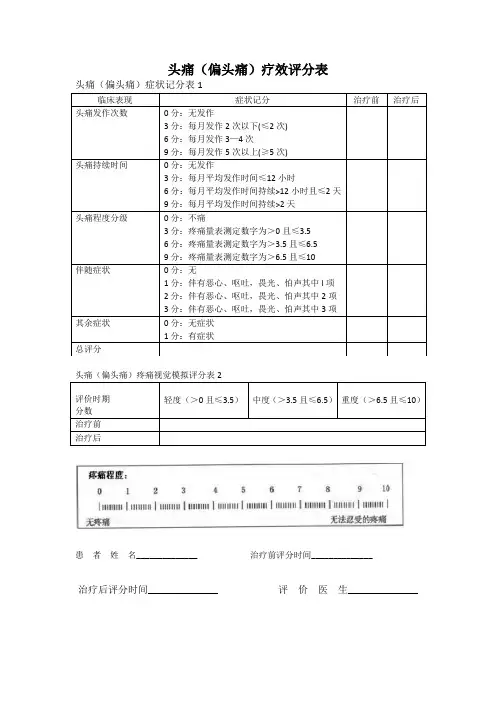
穴位图头穴穴位图—头穴头穴头穴共有14穴:1.枕下旁线,2.枕上旁线,3.枕上正中线,4.颞后线,5.颞前线,6.顶旁2线,7.顶旁1线,8.顶颞后斜线,9.顶颞前斜线,10.顶中线,11.额旁3线,12.额旁2线,13.额旁1线,14.额中线。
1.枕下旁线(标准头穴线)[部位] 在后头部,从膀胱经玉枕穴向下引一直线,长2寸。
[主治] 小脑疾病引起的平衡障碍、后头痛等。
2.枕上旁线(标准头穴线)[部位] 在后头部,由枕外粗隆督脉脑户穴旁开0.5寸起,向上引一直线,长1.5寸。
[主治]皮层性视力障碍、白内障、近视等。
3.枕上正中线(标准头穴线)[部位] 在后头部,即督脉强间穴至脑户穴一段,长1.5寸。
[主治] 眼病、足癣等。
X 4.颞后线(标准头穴线)[部位] 在头的颞部,从胆经率谷穴向下至曲鬓穴连一直线。
[主治] 偏头痛、耳鸣、耳聋、眩晕等。
5.颞前线(标准头穴线)[部位] 在头的颞部,从胆经颔厌穴至悬厘穴连一直线。
[主治] 偏头痛、运动性失语、周围性面经神麻痹和口腔疾病。
6.顶旁2线(标准头穴线)[部位] 在头顶部,督脉旁开2.25寸,从胆经正营穴向后引一直线,长1.5寸到承灵穴。
[主治]肩、臂、手等病证,如瘫痪、麻木、疼痛等。
7.顶旁1线(标准头穴线)[部位] 在头顶部,督脉旁1.5寸,从膀胱经通天穴向后引一直线,长1.5寸。
[主治] 腰腿病证,如瘫痪、麻木、疼痛等。
8.顶颞后斜线(标准头穴线)[部位] 在头顶部,头侧部,顶颞前斜线之后1寸,与其平行的线。
从督脉百会至颞部胆经曲鬓穴引一斜线。
[主治]全线分5等份,上1/5治疗对侧下肢和躯干感觉异常,中2/5治疗加载中...内容加载失败,点击此处重试加载全文上肢感觉异常,下2/5治疗头面部感觉异常。
9.顶颞前斜线(标准头穴线)[部位] 在头顶部,头侧部,从头部经外奇穴前神聪(百会前1寸)至颞部胆经悬厘引斜线。
[主治]全线分5等份,上1/5治疗对侧下肢和躯干瘫痪,中2/5治疗上肢瘫痪,下2/5治中枢性面瘫、运动性失语、流涎、脑动脉粥样硬化等。
偏头痛-特异生活质量(MSQOL)2-是的,很重要3-不,不重要4-不,一点也不重要8.因为偏头痛,我担心自己会忽略周围的人。
(请您画出您选择的号码)1-是的,我非常担心2-是的,我很担心3-是的,我有些担心4-不,我一点也不担心9.因为偏头痛,我怨恨自己耽误时间。
(请您画出您选择的号码)1-是的,我非常怨恨2-是的,我很怨恨3-是的,我有些怨恨4-不,我一点也不怨恨10.4-不因为偏头痛,我不喜欢依靠别人。
(请您画出您选择的号码)1-是的,我非常不喜欢2-是的,我不喜欢3-不,我不这样认为4-不,我一点也不这样认为11.因为偏头痛,我不愿意做计划。
(请您画出您选择的号码)1-是的,我非常不愿意2-是的,我不愿意3-不,我不勉强4-不,我一点也不勉强12.因为恐惧偏头痛发作,我要尽量避免过多活动。
(请您画出您选择的号码)1-是的,我全力尽量避免2-是的,我会避免3-不,我不会避免4-不,我根本不在乎13.如果长途旅行,我担心会出现偏头痛发作。
(请您画出您选择的号码)1-是的,我非常担心2-是的,我很担心3-是的,我有些担心4-不,我一点也不担心14.偏头痛使我的亲朋好友紧张。
(请您画出您选择的号码)1-是的,非常紧张2-是的,很过分紧张3-不,不过分有点紧张4-不,一点也不过分,一点也不15.我尽量不去会导致偏头痛发作的地方(例如,光亮、嘈杂或烟雾弥漫的地方)。
(请您画出您选择的号码)1-是的,我全力尽量避免2-是的,我会避免3-不,我不会避免4-不,我根本不在乎16.因为偏头痛,我为将来担心。
(请您画出您选择的号码)1-是的,我非常担心2-是的,我很担心3-是的,我有些担心4-不,我一点也不担心17.因为偏头痛,我避免自己太努力。
(请您画岀您选择的号码)1-是的,我全力尽量避免2-是的,我会避免3-不,我不会避免4-不,我根本不在乎18.如果感觉快要发作偏头痛,我会紧张。
(请您画出您选择的号码)1-是的,我非常紧张2-是的,我很紧张3-是的,我有些紧张4-不,我一点也不紧张19.偏头痛发作时我觉得抑郁。
两点划分法(Two pont Codcs):12/21:出现这样测图的人常有躯体疾病伴抑郁情绪。
躯体问题可能为功能的或器质的。
如出现1、2、3三联点,则肯定为疑病患者。
量表2高分常与防御功能衰竭有关。
在起病时抑郁有焦急与急性严重的体诉。
此测图亦见于器质性慢性疼痛患者,但亦可能为目前突然加重的疼痛。
这个双高点分亦可见于近期发生急性意外的人,其抑郁是急性的。
为对严重损伤的一种反应。
客观上可见到其身体损伤以及近期发生疼痛的疾患。
许多作者报导12/21型测图者都有器质损伤或心身疾病。
有时这种人的疼痛有夸大倾向因而常易误诊为身体功能性痛疼(如抽筋、扭筋样疼痛),由于疼痛有夸大成份,比较不易引起人们的同情但亦应认真检查以防漏诊。
精神科病人如有这种测图表示为药瘾、酒患癖者。
这组高分者可诊断为疑病性焦虑,或抑郁性神经症。
如为1、2、7测图可诊断为焦虑性神经症。
如为1、2、4;1、2、3或、2、6、4测图则提示有人格障碍,但不诊断为病态人格而应提示为被动专横人格,急性抑郁状态伴依赖性人格。
如为1、2、8测图并伴有F量表高分者可诊断为精神分裂症未分化型。
13/31:此型测图主要指1/3双高点测图。
有量表2低分这种有常有许多体诉,有典型的转换性癔症表现。
这种测图亦见于许多慢性疼痛患者。
常见许多的器质性原因为髓核脱出或椎间盘破裂,这种人常无焦虑反应。
量表2的T分各不相同。
D量表分数较高者有境遇压力不可能有焦虑经验。
如量表2T分特别低时慢应考虑转换性癔症。
这样的测图常伴有量表4高分与量表5(f)低分或量表5(m)高分。
所有13/31测图各种类型无论功能性或器质性疼痛的夸张肯定有强烈的精神因素,这种人与人相处关系肤浅,缺乏与异性打交道的技术(这种特点在量表5,0 中可以找到线索)。
这种人常压抑个人仇恨(在表量6 低分或相对高分数时多见)。
如量表6T分很低,提示有强烈的主动压抑倾向。
这种倾向表现为病人遇到极严重的困难时过伤控制自己,并能在一定阵“阵怒”中把仇恨释放出来(特别在量表4出现高分时)。
激痛点肌肉占人体总体重的60%以上,我们的身体大部分由它组成。
它们负责人体的所有运动。
因为有如此重大的责任,我们就很容易理解肌肉是如何遭受疲乏、撕裂、使用过度和反复损伤。
当我们想移动或使用肌肉时,肌肉会典型的随意收缩。
然而,有时整个肌肉会不随意收缩,我们称之为痉挛。
肌肉的一小部分不随意收缩,产生疼痛和功能障碍,我们称为激痛点状态。
肌肉松弛剂对激痛点无效,原因之一就是药物要足够强效才可以阻止所有的肌肉不随意收缩,一个很重要的不随意肌------心脏,可能会不同意。
研究表明,激痛点是肌肉骨骼疼痛最常见的原因。
疼痛科医生发现,目前将近75%的疼痛是由激痛点引起的。
激痛点引起肌肉持续紧张,进而使肌肉无力,并且增加肌肉骨骼连接处的应力。
这通常导致关节附近疼痛,激痛点区别于其他肌肉疼痛的一个显著特征就是------激痛点总是牵涉身体其他部位的疼痛。
这就是很多疗法无效的原因。
大多数疗法认为疼痛区域也就是疼痛的来源,而真正的病因可能来自一个完全不同的位置。
激痛点和它们的牵涉疼和很多疾病有联系,甚至可能直接导致它们中的一些。
你可以学习如何在家通过治疗激痛点来控制肌肉骨骼痛,让你远离昂贵的医疗费。
你可以使用压力计来治疗下列常见病:·周期性偏头痛·紧张性头痛·颈颌痛·上背痛·肩胛间区烧灼感·胸廓出口综合征·肩周炎·网球肘·腕管综合征·胳膊和手疼痛、麻木、刺痛·关节炎·滑囊炎·肌腱炎·鼻窦疼痛、充血·纤维性肌痛·肌肉关节僵硬激痛点疗法激痛点疗法可以减轻疼痛,增加活动,使肌肉伸长并再次变得强壮。
要治疗激痛点,必须施加较大力量。
力度不够不能有效治疗激痛点,实际上,由于肌肉会自我保护,很可能加重痉挛并导致持久疼痛。
相反,施加在激痛点上的中重度力量,起初会引起疼痛加重,但随着肌肉的放松,疼痛会消失。